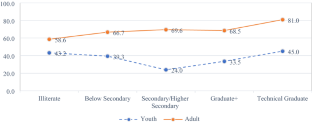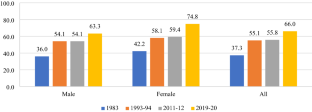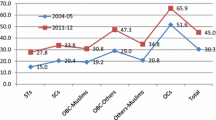Abstract
The issue of youth employment is a global challenge. In India it has emerged increasingly as a daunting challenge over the years. This paper looks into various dimensions of the youth employment and unemployment in terms of their labour market characteristics. The challenge is particularly analysed in terms of ongoing demographic transition, regional diversities and changing pattern of labour markets. It also provides some policy pointers to address the challenge.

Source: Report of the Technical Group on Population Projections, 2020, Ministry of Health and Family Welfare, Government of India

Source: PLFS, 2019–20, NSSO

Source: EUS and PLFS, NSSO, 1983, 1993–94, 2011–12 and 2019–20

Source: EUS and PLFS, NSSO, 2011–12 and 2019–20
Similar content being viewed by others
Notes
: Occupation/skill level is divided into four broad categories using NCO (National Classification of Occupations) at one digit:
I: Typically involves the performance of simple and routine physical or manual tasks (NCO code 9- Elementary Occupations or unskilled such as domestic helpers, cleaners, street vendors and garbage collectors etc.).
II: Typically involves the performance of tasks such as operating a machinery and electronic equipment, driving vehicles, maintenance and repair of electrical and mechanical equipment and manipulation, ordering and storage information (NCO code 4-8, low skilled as clerical jobs, service workers, shop and market sales workers, craft and related trade workers, etc.).
III: Typically involves performance of complex technical and practical tasks that require an extensive body of factual, technical and procedural knowledge in a specialized field (NCO code 3, as professional and technical associates); and.
IV: Typically involves the performance of tasks that require complex problem solving, decision making and creativity based on an extensive body of theoretical and factual knowledge in a specialised field (NCO 2 as professional and Technicians).
The concept of skill level was not applied in the case of NCO code 1 as legislators and managers as skills for executing task and duties of these occupations varied to such an extent that it was not feasible to link them with any of the four broad skill levels. (OECD. OECD Employment Outlook 2014; National Classification of Occupations, 2015, Ministry of Labour and Employment, Government of India 1.).
The skills are defined based on two classifications, one by using number of years of formal education, and another, based on occupations (1 digit NCO – 04) in India.
(i) Skill based on formal years of schooling: In the Indian context, the skills necessary to perform the tasks and duties of a given job can be acquired not only through formal education but also through informal training and experience. The four skill levels thus defined for NCO – 04 vis-à-vis the skill levels defined in ISCO – 88 are as.
I: Up to 10 years of formal education and/or informal skills;
II: 11–13 years of formal education;
III: 14–15 years of formal education; and.
IV: More than 15 years of formal education.,
(ii) Skill based on occupations or task performed: In keeping with the skill levels defined above to suit the Indian conditions, the following four divisions are classified in tune with the defined skill levels to accommodate occupations (NCO code 1 digit) same as given in Table 6 as.
I: Typically involves the performance of simple and routine physical or manual tasks (NCO code 9- Elementary Occupations or unskilled such as such as domestic helpers, cleaners, street vendors and garbage collectors etc.); II: Typically involves the performance of tasks such as operating a machinery and electronic equipment, driving vehicles, maintenance and repair of electrical and mechanical equipment and manipulation, ordering and storage information (NCO code 4-8, low skilled as clerical jobs, service workers, shop and market sales workers, craft and related trade workers etc.);
III: Typically involves performance of complex technical and practical tasks that require an extensive body of factual, technical and procedural knowledge in a specialised field (NCO code 3, as professional and technical associates); and.
IV: Typically involves the performance of tasks that require complex problem solving, decision making and creativity based on an extensive body of theoretical and factual knowledge in a specialised field (NCO 2 as professional and technicians).
Skill Mismatch: The skill-mismatch arises by the difference between type (i) and type (ii), when workers skill level based on education is higher than skill level based on occupation (workers are overeducated); when workers skill level based on education is lower than the skill level based on occupation (workers are undereducated), and if no difference in both level of skills (workers have matching skill). Source: (OECD. OECD Employment Outlook 2014; National Classification of Occupations, 2015, Ministry of Labour and Employment, Government of India).
This is shown by India Skill Report 2021, prepared by Wheebox, in partnership with Tagged, CII, AICTI, AIU and UNDP.
Informal employment consists of those working in the informal enterprises or households, excluding regular workers with social security benefits, and the workers in the formal sector without any employment/social security benefits provided by the employers (NCEUS 2007).
References
Chaudhary, R., & Verick, S. (2014). Female labour force participation in India and beyond. New Delhi: ILO.
Dasgupta, S., & Verick, S. S. (Eds.). (2016). Transformation of women at work in Asia: An unfinished development agenda. SAGE Publications India.
Endow, T.& Mehta, B. S. (2022). Rethinking Education and Livelihood in India. Journal of Human Values 28 (1): 29–43.
Ficci, N. E. Y. (2017). Future of jobs in India: A 2022 perspective. New Delhi: Ernst and Young LLP.
Ghose, A. K. (2020). Structural transformation of India’s economy. IHD Working Paper No. WP01/2020]. https://www.ihdindia.org.
Ghose, A.K., & Kumar, A. (2021). India’s deepening employment crisis in the time of rapid economic growth. The Indian Journal of Labour Economics 64 (2): 247–279.
Ghose, A. K. (2016). India Employment Report 2016. New Delhi: Institute for Human Development and Oxford University Press.
ILO (2015). What Does NEETs Mean and Why is the concept so easily misinterpreted? Work for Youth, Technical Brief No.1, January.
ILO (2019–20). Young People Not in Employment, Education or Training, Technical brief No 3, ILO/SIDA Partnership on Employment.
ILO (2020a). Global Employment Trends for Youth 2020: Technology and the future of jobs, 2020. Geneva: ILO.
ILO (2020b). Tackling the COVID-19 youth employment crisis in Asia and the Pacific. International Labour Organization and Asian Development Bank 2020b
ILO (2021). Young person’s not in employment and education (NEET) in India: 2000–2019, Research Brief.
India Labour Employment Report (ILER, 2014): Workers in the Era of Globalisation, Academic Foundation, New Delhi and Institute for Human Development, Delhi
India Start-up Outlook Report, (2017). ‘Innoven Capital: India startup outlook report, 2017’, accessed from http://www.innovencapital.com/sites/default/files/
Institute for Human Development (IHD) and UNDP (2021), Strategies for Promoting Education to Work Transition Landscape in India, Report prepared for the UNDP (mimeo).
Kapsos, S., Silberman, A., & Bourmpoula, E. (2016). Decline of Women‟ s Labour Force Participation in India in. Transformation of women at work in Asia: An unfinished development Agenda, 75.
Mehta, B.S., & Shree, M. (2017). Inequality, gender and socio-religious groups. Economic and Political Weekly 52 (8): 56–60.
Mehta, B. S., Laha, S. & Sharma, A. N. (2022), Indian labour market: post-liberalisation trajectory and the arrival of digital technology’, SCIS Working Paper, Number 28, WITS University.
Mehta, B. S., & Awasthi, I. C. (2019). Women and Labour Market. Dynamics’: Springer Books.
Ministry of Youth Affairs and Sports, Government of India (2014). National Youth Policy 2014.
MGI (2020). India’s turning point: An economic agenda to spur growth and jobs, Mckinsey Global Institute, August 2020.
Mitra, A., & Sher, V. (2013). Youth employment and unemployment: an Indian perspective. ILO Asia-Pacific, DWT for South Asia and Country Office for India, New Delhi: ILO, Working Paper Series
NCEUS (2007). Report on the Condition of Work and Promotion of livelihoods in the Unorganised Sector. National Commission for Enterprises in the Unorganised Sector. New Delhi: Dolphin Printo Graphics.
Periodic Labour Force Survey (PLFS) (2020). Ministry of Statistics and Programme Implementation, National Statistical Office, June.
Pieters, J. (2013). Youth Employment in Developing Countries, I Z A Research Report No. 58, October, Background paper prepared under Service Contract DCI-EDUC/2012/310–255, the European Commission.
Sasikumar, S. K. (2019). Youth and the Labour Market Landscape in India: Issue and Prospective. NLI Research Studies Series No. 140.
Sharma, N. A., & Balwant, S. M. (2017). Job Creation: Challenges and Way Forward. YOJNA, June, 2017.
UNICEF (2019). Developing Skills in Youth to Succeed in the Evolving South Asian Economy: India Country Report. 2019.
Funding
No external source of funding was used.
Author information
Authors and Affiliations
Corresponding author
Ethics declarations
Conflict of interest
The author declares that he has no conflict of interest.
Additional information
Publisher's Note
Springer Nature remains neutral with regard to jurisdictional claims in published maps and institutional affiliations.
Appendix
Appendix
See Tables 1A, 1B, 2A, 2B and 3A
.
Rights and permissions
About this article
Cite this article
Sharma, A.N. Youth Employment and Unemployment in India: Issues and Challenges. Ind. J. Labour Econ. 65, 237–267 (2022). https://doi.org/10.1007/s41027-022-00387-5
Accepted:
Published:
Issue Date:
DOI: https://doi.org/10.1007/s41027-022-00387-5




